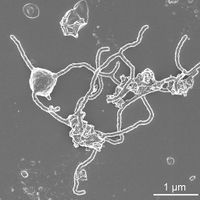Candidatus Prometheoarchaeum: Difference between revisions
| Line 40: | Line 40: | ||
Interesting features of cell structure; how it gains energy; what important molecules it produces. | Interesting features of cell structure; how it gains energy; what important molecules it produces. | ||
Candidatus Prometheoarchaeum syntrophicum’ strain MK-D1—is an anaerobic, extremely slow-growing, small coccus (around 550 nm in diameter) that degrades amino acids through syntrophy. | |||
==Ecology and Pathogenesis== | ==Ecology and Pathogenesis== | ||
Revision as of 20:40, 30 April 2020
Classification
Domain: Archaea
Kingdom: Proteoarchaeota
Superphylum: Asgard
Phylum: Lokiarchaeota
Genus: Candidatus
Species: Prometheoarchaeum syntrophicum "Imachi et al. 2020"
Strain: MK-D1
Use NCBI link to find]
Species
|
NCBI: Taxonomy |
Candidatus Prometheoarchaeum syntrophicum strain MK-D1
Description and Significance
Describe the appearance, habitat, etc. of the organism, and why you think it is important.
Current data suggest that eukaryotes may have risen from the archaeal lineage known as "Asgard archaea" (Spang A. et al. 2015). Although a resemblance of eukaryote-like genomic features have been discovered in these archaea, the evolutionary transition from archaea to eukaryotes remains uncertain due to the lack of cultured representatives and corresponding physiological insights.
Genome Structure
Describe the size and content of the genome. How many chromosomes? Circular or linear? Other interesting features? What is known about its sequence?
Cell Structure, Metabolism and Life Cycle
Interesting features of cell structure; how it gains energy; what important molecules it produces.
Candidatus Prometheoarchaeum syntrophicum’ strain MK-D1—is an anaerobic, extremely slow-growing, small coccus (around 550 nm in diameter) that degrades amino acids through syntrophy.
Ecology and Pathogenesis
Habitat; symbiosis; biogeochemical significance; contributions to environment.
If relevant, how does this organism cause disease? Human, animal, plant hosts? Virulence factors, as well as patient symptoms.
References
Imachi H, Nobu MK, Nakahara N, et al. Isolation of an archaeon at the prokaryote-eukaryote interface. Nature. 2020;577(7791):519‐525. doi:10.1038/s41586-019-1916-6
Spang, A. et al. Complex archaea that bridge the gap between prokaryotes and eukaryotes. Nature 521, 173–179 (2015).
Author
Page authored by Jeremy Eugene Patrick, student of Prof. Jay Lennon at Indiana University.

